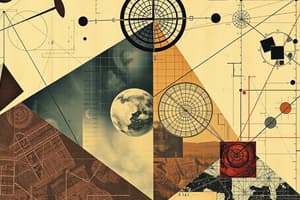Podcast
Questions and Answers
What is the primary focus of computer science?
What is the primary focus of computer science?
- Managing investments and assessing risk
- Developing algorithms and creating artificial intelligence (correct)
- Analyzing market trends and predicting economic growth
- Designing structures and analyzing systems
Which type of geometry deviates from the axioms of Euclidean geometry?
Which type of geometry deviates from the axioms of Euclidean geometry?
- Analytic Geometry
- Descriptive Geometry
- Projective Geometry
- Non-Euclidean Geometry (correct)
What is the first step in the problem-solving strategy?
What is the first step in the problem-solving strategy?
- Looking back
- Devising a plan
- Understanding the problem (correct)
- Carrying out the plan
Which mathematical symbol represents 'not equal to'?
Which mathematical symbol represents 'not equal to'?
In finance, what does assessing risk involve?
In finance, what does assessing risk involve?
Which branch of mathematics primarily focuses on angles and sides of triangles?
Which branch of mathematics primarily focuses on angles and sides of triangles?
What is the main operation involved in multiplication?
What is the main operation involved in multiplication?
Which mathematical structure involves sets with two operations satisfying distributive properties?
Which mathematical structure involves sets with two operations satisfying distributive properties?
What concept involves collecting and analyzing numerical data?
What concept involves collecting and analyzing numerical data?
What is a property of a field in mathematics?
What is a property of a field in mathematics?
Which mathematical field focuses on change and motion?
Which mathematical field focuses on change and motion?
In what type of mathematical operation would you be 'finding how many times one quantity is contained within another'?
In what type of mathematical operation would you be 'finding how many times one quantity is contained within another'?
Which area of mathematics uses variables and symbols to express relationships?
Which area of mathematics uses variables and symbols to express relationships?
Flashcards
Arithmetic
Arithmetic
Deals with basic operations like addition, subtraction, multiplication, and division on numbers.
Algebra
Algebra
Uses symbols and variables to represent numbers and relationships between them, allowing for generalizations of arithmetic concepts.
Geometry
Geometry
Focuses on shapes, sizes, positions, and properties of figures in space.
Trigonometry
Trigonometry
Signup and view all the flashcards
Calculus
Calculus
Signup and view all the flashcards
Statistics
Statistics
Signup and view all the flashcards
Probability
Probability
Signup and view all the flashcards
Sets
Sets
Signup and view all the flashcards
Euclidean Geometry
Euclidean Geometry
Signup and view all the flashcards
Non-Euclidean Geometry
Non-Euclidean Geometry
Signup and view all the flashcards
Analytic Geometry
Analytic Geometry
Signup and view all the flashcards
Problem-Solving Strategy
Problem-Solving Strategy
Signup and view all the flashcards
Study Notes
Branches of Mathematics
- Arithmetic: Deals with basic operations like addition, subtraction, multiplication, and division on numbers.
- Algebra: Uses symbols and variables to represent numbers and relationships between them, allowing for generalizations of arithmetic concepts.
- Geometry: Focuses on shapes, sizes, positions, and properties of figures in space.
- Trigonometry: Studies relationships between angles and sides of triangles, crucial for applications in navigation and physics.
- Calculus: Deals with change and motion. Two main branches: differential calculus (rates of change) and integral calculus (accumulation of quantities).
- Statistics: The collection, analysis, interpretation, presentation, and organization of numerical data.
- Probability: Deals with the likelihood of events occurring.
Fundamental Concepts
- Sets: Collections of objects.
- Numbers: Different types (natural, integers, rational, irrational, real, complex).
- Functions: Relationships between inputs and outputs.
- Equations: Statements of equality between expressions.
- Inequalities: Statements showing the relationship between expressions as greater than, less than, etc.
- Logic: The study of valid reasoning and argumentation.
Key Mathematical Operations
- Addition: Combining quantities.
- Subtraction: Finding the difference between quantities.
- Multiplication: Repeated addition.
- Division: Repeated subtraction or finding how many times one quantity is contained within another.
Important Mathematical Tools
- Variables: Symbols representing unknown or changing values.
- Formulas: Equations representing specific relationships, like area of a rectangle, or volume of a cube, or laws of gravity.
- Graphs: Visual representations of mathematical relationships.
- Diagrams: Visual aids used to represent sets, relationships, and geometric figures.
Common Mathematical Structures
- Groups: Sets equipped with an operation satisfying certain axioms of closure, associativity, identity, and inverse.
- Rings: Sets equipped with two operations (addition and multiplication) satisfying specific axioms like distributivity.
- Fields: A type of ring in which every nonzero element has a multiplicative inverse.
- Vectors: Quantities having both magnitude and direction.
- Matrices: Rectangular arrays of numbers used to represent linear transformations, solve systems of equations, and more.
Applications of Mathematics
- Physics: Describing motion, force, energy, and other physical phenomena.
- Engineering: Designing structures, analyzing systems, and optimizing processes.
- Computer Science: Developing algorithms, modeling data, and creating artificial intelligence.
- Economics: Analyzing market trends, predicting economic growth, understanding supply and demand.
- Finance: Managing investments, assessing risk, and modeling financial instruments.
Types of Geometry
- Euclidean Geometry: Based on axioms defining points, lines, planes, and their relationships.
- Non-Euclidean Geometry: Geometries deviating from Euclidean axioms, significant in modern physics.
- Analytic Geometry: Uses coordinates and algebraic methods to analyze geometric problems.
Problem Solving Strategies
- Understanding the problem: Identifying the key information and what is to be found.
- Devising a plan: Selecting methods such as using formulas, creating diagrams, or breaking down complex problems.
- Carrying out the plan: Executing the chosen strategy showing calculations, steps in an orderly fashion.
- Looking back: Checking the reasonableness of the answer and refining the approach.
Mathematical Symbols and Notation
- = (equals).
- ≠ (not equal to).
-
(greater than).
- < (less than).
- ≥ (greater than or equal to).
- ≤ (less than or equal to).
- √ (square root).
- π (pi).
- ∑ (summation).
- ∫ (integral).
- ∞ (infinity).
- ∆ (change).
Studying That Suits You
Use AI to generate personalized quizzes and flashcards to suit your learning preferences.



